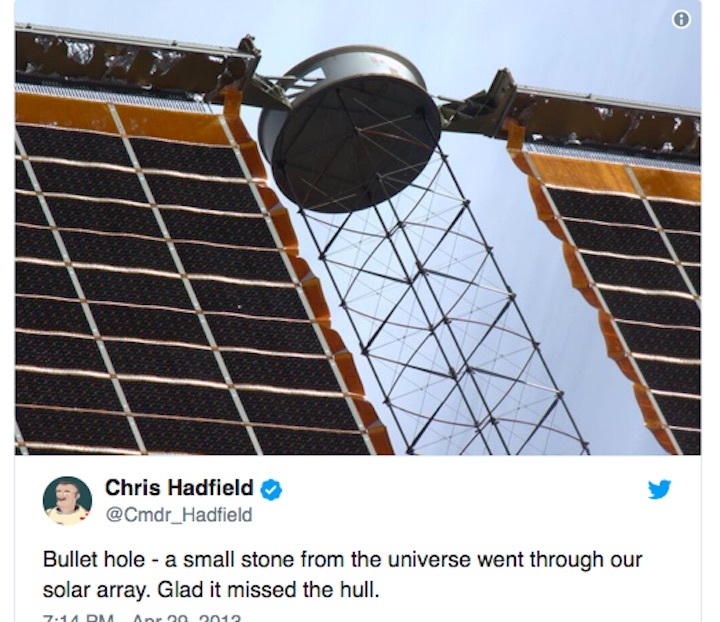22.07.2018

This post is part of Science of Sci-Fi, Mashable's ongoing series dissecting the science (or lack of science) in our favorite sci-fi movies, TV shows, and books.
Thanks to fictional depictions, we tend to think of spaceships as well-fortified machines. But in reality, even in the emptiness of outer space, their hulls would be under threat of bombardment from near-invisible enemies.
In the Star Wars and Star Trek franchises, ships are usually fitted with deflector shields — zones of energy that absorbed beams of enemy fire. The USS Enterprise, for example, could repel an enemy's colorful phaser blasts by putting its shields up. To increase dramatic tension, those shields generally didn't hold up for long.
Back in our century, the science of deflector shields doesn't hold up for long either. (The Star Trek version relied on "gravitons," a hypothetical particle we haven't discovered yet.) Good thing we haven't yet discovered any Romulans, Klingons, or other intelligent adversaries we need to rebuff.
But during missions through our solar system, spacecraft already need to be protected against a less visible enemy: speeding micrometeorites.
"Those things are coming at you pretty fast," says Mia Siochi, a NASA research materials engineer.
Smaller than a grain of sand, micrometeorites are hard bits that have broken off asteroids and are zooming through space at some 15,000 mph — or nearly 10 times the speed of a bullet.

That explains why our satellites and other space vessels have already received the metallic equivalent of gunshot wounds — and why NASA's Siochi and other engineers have developed a futuristic material that can, when punctured, heal itself.
"They’ll heal back up, self-repair, and continue to function," she said.
The tiniest alien threat
To life on Earth, micrometeorites aren't thought of as dangerous — because here they're not. These minuscule objects tend to vaporize in our upper atmosphere.
Yet "in space, no blanket of atmosphere protects a spacecraft or a spacewalker," warns NASA.
On the International Space Station, for instance, the habitats are layered with thick Kevlar and aluminum "Whipple Shields," and for good reason. Astronauts, peering out of the space station windows, have witnessed close-calls to the exposed space station — including a "bullet hole" left in a solar array.
"Glad it missed the hull," Commander Chris Hadfield tweeted in 2013.

Micrometeorites need not tear through a spacecraft wall to cause a small ruckus. They sometimes leave millimeter-sized craters in aluminum siding. One even pinged off a space station window, damaging the thick glass.
But out beyond Earth's orbit, spacecraft can't be easily repaired — or escaped in an emergency — like the space station can. Punctures need to be repaired, ideally in a matter of microseconds. Therefore this must be done without the help of any astronaut or spacecraft mechanic.
To fix this problem, NASA and university engineers are working on what they call "Rapid Puncture-Initiated Healing" material. To self-heal, it performs a kind of space judo — using the energy of the micrometeorite against itself.
Think of the material as a three-layered wall, with two solid outside layers, and a liquid inner layer. When a projectile moving at some 15,000 miles per hour pierces the entire wall, it generates friction and heat as it passes through.
This short-lived heat stimulates the liquid to rapidly flow and fill the hole in a few microseconds. It then solidifies, preserving the wall, and perhaps, the spacecraft.
Siochi and her team tested the material with the fastest projectiles on Earth: bullets. "We were actually using a gun," Siochi said, during a test that took place in a specialized government facility.
After the bullets stopped flying, engineers examined the material, and found evidence that it had successfully healed.

This material isn't just able to self-repair. It may also make spacecraft lighter, said Siochi.
Future spaceships are depicted as giant cosmic SUVs, layered with vast chunks of metal, laser cannons and so forth. Such science fiction concepts might exist in the deep future, once we're a fully spacebound species.
But in the short term, our ships are still dependent on powerful rockets to leave the Earth. This puts a limit on how large and heavy any spacecraft can be — and gives lighter vessels a significant advantage. They won't need to use as much fuel.
When NASA's material researchers are called upon to put self-healing walls to use, they'll be ready, said Siochi. Someday, perhaps, a spacecraft zooming through an alien solar system will be able to heal its walls from a zone of debris and meteor-ridden space, en route to visit a curious, uncharted planet.
That spacecraft's captain won't even have to insist on putting the shields up.
